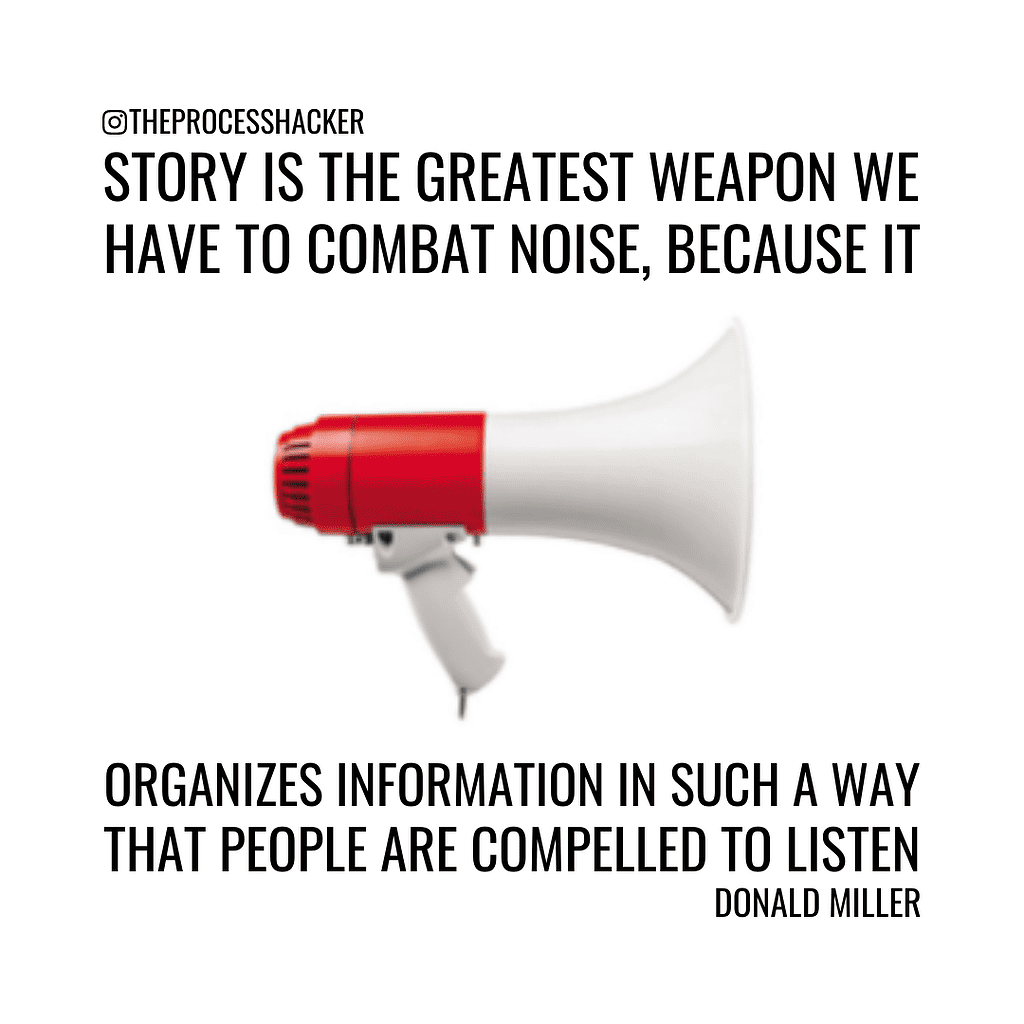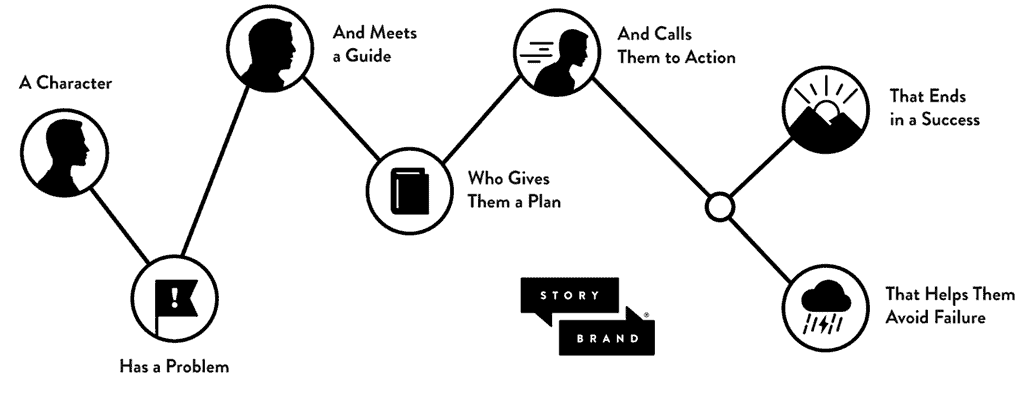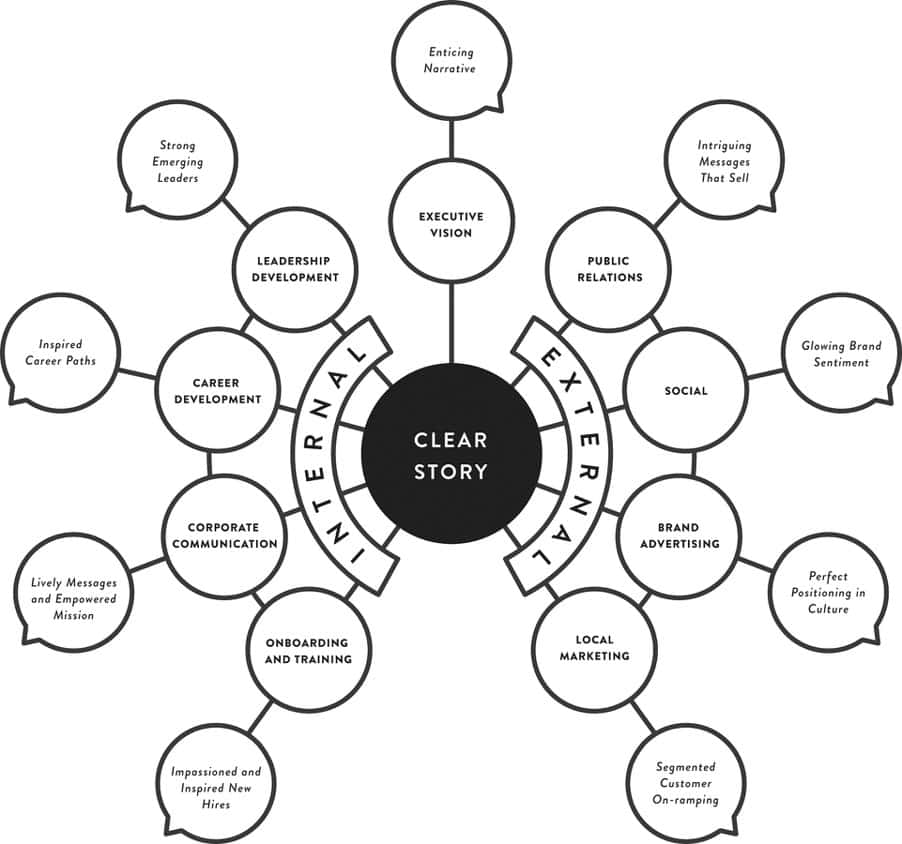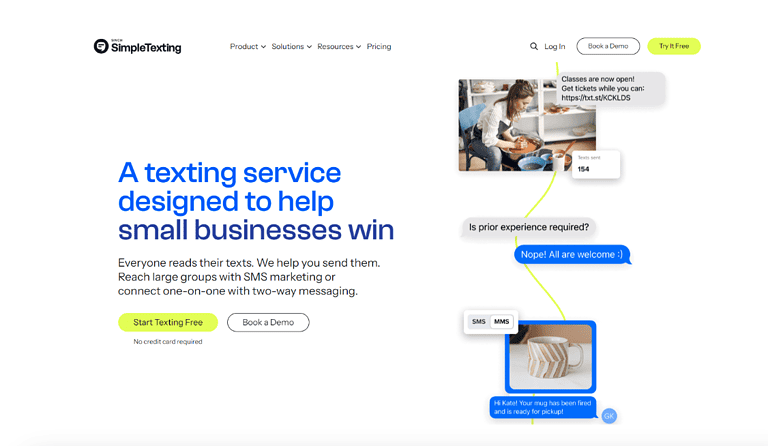Building a StoryBrand by Donald Miller | Summary
Avoid telling your company’s story, as customers really don’t care. Instead, invite them into their own heroic story. In Building a StoryBrand: Clarify Your Message So Customers Will Listen, Donald Miller helps you take your customers through their journey to effectively explain what your company offers.
The book outlines the StoryBrand (SB7) Framework, which is a seven-part process. The framework will clarify your message, organize your thoughts, simplify your marketing, and grow your business. It will change the way you talk about your business and maybe the way you conduct business.
Download the PDF Book Summary for Building a StoryBrand
Section 1: Why Most Marketing Is Ineffective

Despite having a great product or service, many businesses struggle to communicate how it improves their ideal customers’ lives. As a leader, you need your story to be centered around your customers to interest them to do business with you.
Problem: Why Do So Many Businesses Fail?
Most businesses have not clarified their message and make the following mistakes:
- Fail to focus on the features of their offer that will help people succeed
- Cause their customers to struggle to understand what they are offering.
- Confuse their customers with clutter and noise in their marketing.
Solution: How Can You Use Stories To Combat The Noise?
“Story is the greatest weapon we have to combat noise, because it
information in such a way that people are compelled to listen.” Understanding how the story integrates with your brand message will enable you to build a StoryBrand narrative to better engage more customers and grow your business.
7 Elements of a Story

- A Character
- Has a Problem
- And meets a Guide
- Who gives them a Plan
- And calls them to Action
- That helps them avoid Failure
- And ends in a Success
3 Critical Questions
These questions will provide clarity for the story that your company is narrating:
- What does the hero want?
- Who or what is opposing the hero from getting what she wants?
- What will the hero’s life look like if she does (or does not) get what she wants?
Marketing Grunt Test
Potential customers must answer these questions to engage with our brand within five seconds of looking at our website or marketing material:
- What do you offer?
- How will it make my life better?
- What do I need to do to buy it?
The StoryBrand (SB7) Framework

The StoryBrand BrandScript is a simple, fun, and practical tool for the StoryBrand Process. The tool will clarify your message, improve your productivity, and inspire effective marketing material.
Donald Miller provides a website to help you create your StoryBrand for free. When finished, your StoryBrand BrandScript or brand message will fit on a single sheet of paper, which is shown above.
Download the PDF Book Summary for Building a StoryBrand
Section 2: Building Your StoryBrand
In this section, each chapter deep dives into the seven elements of the StoryBrand (SB7) Framework. Each part of the StoryBrand BrandScript is essential to building your brand and enticing customers.
You can create your StoryBrand BrandScript here. As you read through each element, brainstorm potential messages and determine a specific message for each section of the BrandScript.
Element 1: A Character

StoryBrand Principle 1: “The customer is the hero, not your brand.”
First, you need to identify your ideal customers when building a StoryBrand.
The Hero: Who Are Your Customers?
Your customers, not your brand, will be the heroes of their story:
Hero – the main character or the protagonist that drives the plot forward in the face of adversity using ingenuity, courage, or strength
You should honor the audience’s journey and position yourself as the authority to help them overcome their challenges and achieve what they want to succeed.
Story Gap: What Do Your Customers Want?
Next, determine the story gap or what they want:
Story Gap – the potential desire of your customer
The hero wants something, and you need to communicate it simply with the story providing them with definition and direction. When you define something your customer wants, you invite them to change their story in your direction. Also, focus on one simple desire for your customer.
Survival: What Desires Fulfill Their Sense of Survival?
Next, choose a want that fulfills the customer’s sense of survival:
Survival – the primitive desire we all have to be safe, healthy, happy, and strong; examples of desires:
- Conserve Financial Resources – helps save money and resources
- Conserve Time – helps save time with the opportunity cost
- Build Social Networks – fulfills the need to nurture and be nurtured
- Gain Status – provides an identity associated with power, prestige, and refinement
- Accumulate Resources – helps make money or gain necessary resources
- Desire to be Generous – achieves an aspirational identity to help others survive
- Desire for Meaning – provides the opportunity to take part in something greater than themselves
Clarify Your Message
- Who are your ideal customers?
- What do your customers want?
- What desires fulfill their sense of survival?
Element 2: Has a Problem

StoryBrand Principle 2: “Companies tend to sell solutions to external problems, but customers buy solutions to internal problems.”
The hero’s story begins with peace and stability; however, that stability disappears when our hero faces adversity. When building a Storybrand, you should discuss the villains and issues that your customers face to get them more interested in your brand, products, and services.
Villain: Who Does Your Brand Stand Against?
The story needs a villain to provide the conflict:
Villain – the character or antagonist that actively negatively opposes the hero; should have the following four characteristics:
- A Root Source – should be a thing or idea, not a feeling, such as higher taxes
- Relatable – should induce negative connotations when presented to your customers
- Singular – should only be one villain, as many villains will be confusing.
- Real – should exist in real life and avoid extreme exaggeration
Levels of Conflict: What Are the Problems That The Villain Is Causing?
The villain causes the three levels of issues that your customers experience in their everyday lives:
- External Problem – a physical, tangible problem the hero must overcome to save the day
- Internal Problem – an internal problem of wanting to resolve a frustration along with the original external problem
- Philosophical Problem – a problem that is larger than the story itself and provides a more profound sense of meaning
The customer has set out on a journey to return to the stable life that they once had. When you help them resolve these three levels of problems, the audience will be excited and relieved, causing them to love the story.
Clarify Your Message
- Who is the single villain your brand stands against?
- What is the external problem that the villain is causing?
- How is that external problem making your customers feel?
- And why is it unjust for people to have to suffer at the hands of this villain?
Element 3: And Meets a Guide

StoryBrand Principle 3: “Customers aren’t looking for another hero; they’re looking for a guide.”
As heroes experience villains and problems, you should be the guide to help them overcome adversity. When building a Storybrand, there are two characteristics (empathy and authority) that will help your customers recognize you as the guide.
Empathy: How Do You Empathize With Your Customer?
You should empathize with your customer’s issues:
Empathy – the ability to understand and share the feelings of another
As the guide, you should express an understanding of your customer’s pain and frustration. By empathizing, you show the customer that you care about earning their trust.
Authority: How Do You Demonstrate Authority To Your Customer?
You should demonstrate authority without bragging or preaching to our customers:
Authority – the power to influence others, primarily because of one’s manner or recognized knowledge about something; ways to demonstrate authority:
- Testimonials – provide satisfied customer reviews to demonstrate success
- Statistics – provide numbers, data, and facts to appeal to analytical customers
- Awards – include achievements that provide credibility
- Logos – include logos of recognizable businesses that you have worked with in the past
Clarify Your Message
- How do you empathize with your customers to show them that you care about their internal problems?
- How do you demonstrate competence and authority?
Element 4: Who Gives Them a Plan

StoryBrand Principle 4: “Customers trust a guide who has a plan.”
The guide provides the hero with the plan or information to overcome their issues and achieve success. When building a Storybrand, you should provide a plan of action (either process plan or agreement plan) to help your customers gain trust and purchase your products or services.
Process Plan: What Steps Are Needed To Do Business With You?
Either you should have a process plan to alleviate confusion:
Process Plan – a series of steps to clarify how someone can do business with you:
- Pre-purchase Process Plan – the steps a customer needs to take to buy your product
- Post-purchase Process Plan – the steps the customer needs to take to use your product after they buy it
Agreement Plan: What Agreements Can You Make To Alleviate Fears?
Or you should have an agreement plan to alleviate fear:
Agreement Plan – list of agreements you make with your customers to remove the risk of doing business with you
Agreement plans can increase the perceived value of your product or service. Also, they can help clarify the shared values between you and your customers.
Clarify Your Message
- What steps do your customers need to take to do business with you?
- What fears do your customers have related to your industry?
- What agreements can you make with your customers to alleviate those fears?
- What unique values do you share with your customers?
Download the PDF Book Summary for Building a StoryBrand
Element 5: And Calls Them to Action

StoryBrand Principle 5: “Customers do not take action unless they are challenged to take action.”
External forces are necessary to challenge the hero to take action and return to stability. Likewise, the call to action communicates a clear and direct way for your customers to solve their problems. When building a Storybrand narrative, you should have calls to action (either direct or transitional) in your messaging to help people engage.
Direct: What Can Be Obvious In Your Marketing?
Either you should be direct in your call to action:
Direct Call to Action – something that leads to a sale, or at least is the first step down a path that leads to a sale, like scheduling an appointment
There should be an obvious button (“buy now,” “call today,” “schedule a call,” etc.) repeated throughout your website. Also, you can include direct calls to action in email newsletters or other advertising.
Transitional: What Can Further Your Customer Relationships?
Or provide a transitional “on-ramp” for prospects to make an eventual purchase:
Transitional Call to Action – something that furthers our relationship with the customer and does the following for our brand:
- Claim your Target Market: Provide value in a specific niche industry so that your brand can stake a claim in that territory.
- Create Reciprocity: Provide value to potential customers for free so that they are more likely to give back or buy in the future.
- Position Yourself as a Guide: Help your customers solve a problem so that they will seek you out as the expert guide.
Here are several ideas for Transitional Calls to Action:
- Free Information – educates your customer about your area of expertise.
- Testimonials – creates social proof of previous customers enjoying your product or service.
- Samples – provides a way for customers to consume your products.
- Free Trial – offers a way to remove risk for customers to try your service.
Clarify Your Message
- What direct calls to action can you create to be made obvious for all your marketing material?
- What transitional calls to action can you develop to claim your target market, create reciprocity with customers, and position yourself as the guide?
Element 6: That Helps Them Avoid Failure

StoryBrand Principle 6: “Every human being is trying to avoid a tragic ending.”
If there is no meaning, there is no story. Either the hero is motivated to escape something terrible or experience something amazing. When building a Storybrand, you should show customers what will happen if they don’t do business with us.
What Is There To Lose?
Your customer will be motivated to buy from their fear of loss or missing out:
- Tell the reader that they are exposed to a threat.
- Show them how to take action to reduce their vulnerability.
- Provide the reader with a specific call to action to protect them from the risk.
- Challenge them to take this particular action.
What Are You Helping Your Customers Avoid?
You only need to warn your customers of a few negative consequences on their finances, health, opportunity costs, etc. If you do overdo it, then customers will resist you. If you underdo it, then they won’t understand why your brand matters.
Clarify Your Message
- What will your customers have to lose if they don’t buy your products?
- What are the negative consequences that are you helping your customers avoid?
Element 7: And Ends in a Success

StoryBrand Principle 7: “Never assume people understand how your brand can change their lives. Tell them.”
The Donald Miller storyline ends with the hero experiencing a happy ending. When building a Storybrand, you should provide a specific and clear happy ending to your customer’s journey. Tell them what their lives will be like if they buy your products or services.
Before and After: What Does It Look Like?
Ask the following questions regarding your customers before and after experiencing your brand:
- What do they have?
- What are they feeling?
- What’s an average day like?
- What is their status?
Regardless of what you sell, present pictures of people enthusiastically using your product or service.
Resolution: How Does The Story End?
There are three primary ways that you can end your customer’s story:
- Winning Power and Position – provide them status by offering access, creating scarcity, offering premiums, and offering identity association
- Union to Make the Hero Whole – provide them with an external person or thing to create completeness by reducing anxiety, reducing workload, and increasing time
- Ultimate Self-Realization or Acceptance – provide them with the need to reach our potential by inspiration, acceptance, and transcendence
Clarify Your Message
- What will your customers’ lives look like if they buy your products and services?
- How will you resolve your customers’ internal, external, and philosophical issues?
Foundational Element: Participate in Their Transformation
At the beginning of the story, the hero is flawed, uncertain, and unprepared for the journey before them. By the end, the hero has transformed to defeat the villain and resolve their problems.
Apparitional Identify: Who Do They Want to Be?
Likewise, people want to change, and you can use your brand to help your customers become better versions of themselves:
- To – define an aspirational identity for your customers.
- From – define the opposite of the aspirational identity captured by the “to”
Clarify Your Message
- Who do your customers want to become?
- What kind of person do your customers want to be?
- What is their aspirational identity?
- How do your customers want to be perceived by others?
Download the PDF Book Summary for Building a StoryBrand
Section 3: Implementing Your StoryBrand BrandScript
Build a Better StoryBrand on Your Website

In the Storybranding book, Donald Miller states that an excellent digital presence starts with a clear and compelling website to convert browsers into buyers. There are five things that your website should include:
- An Offer above the Fold: Above the fold, make sure the images and text promise an aspirational identity, commit to solving a program, and state precisely what you do. The part of your site above the fold refers to the images and text you see and read before you start scrolling down.
- Obvious Calls to Action: Place direct calls to action at (1) the top right of our website and (2) the center of the screen, above the fold.
- Images of Success: Display happy customers that communicate a sense of health, well-being, and satisfaction with our brand.
- A Brief Breakdown of Your Revenue Streams: Present your various corporate divisions clearly so customers can understand your offers and choose the product or service for them.
- Very Few Words: Write in copy that is brief, punchy, and relevant to your customers. Most people skim websites instead of reading them.
Transform Your Company Culture

If your message is unclear, your employees will also get confused, in addition to your customers. Instead, establish a robust StoryBrand-inspired story to get your company and people on a mission.
“A true mission isn’t a statement; it’s a way of living and being.” Your company needs to be on a mission, and it all stems from your StoryBrand BrandScript. If you are interested in a Storybrand Brandscript example for executive coaches, you should check out Donald Miller’s website.
StoryBrand Marketing Roadmap
The StoryBrand Marketing Roadmap will help you implement your Brandscipt using five marketing tactics:
- Create a One-Liner. A One-Liner answers the common question of “What do you do?” and helps people understand why they should do business with you. You should use the following StoryBrand elements to craft a compelling One-Liner:
- The Character: Who are they and what do they want?
- The Problem: What are the challenges that you will resolve?
- The Plan: How will you help them solve their problem?
- The Success: What will life be like after they use your product or service?
- Produce a Lead Magnet and Collect Emails. Create a lead generator to help you qualify prospects. Lead magnets include downloadable guides, online courses, webinars, free trials, live event invites, etc. It should provide a transitional call to action that must:
- Provide an immense amount of value to your customer and
- Position you as an expert in your field or niche
- Create an Automated Email Drip Campaign. Email campaigns remind people that you exist and invite them to engage in the story you are telling. Start with a nurturing campaign, which is a simple, regular email that provides subscribers with valuable information that relates to your business, builds trust, and positions you as the guide. About every third or fourth email, directly offer a call to action to the customer to lead to the sale.
- Gather and Tell Stories of Client Transformations. Showcase how you helped your customers transform through customer testimonials. Feature these testimonials in emails, promo videos, speaks, interviews, etc. The best testimonials will demonstrate:
- The value of your products or services;
- The results achieved by the customer; and
- The experience they got from doing business with you.
- Establish Systems to Generate Referrals. After successfully converting people into customers, encourage them to become evangelists for your brand. Implement an effective referral system by doing the following:
- Identify your existing, ideal customers;
- Provide them a reason to spread your message; and
- Offer a reward in return.
“If you confuse, you’ll lose. But if you clarify your message, customers will listen. Here’s to helping the good guys win. Because in a good story, they always do.”
Download the PDF Book Summary for Building a StoryBrand
Next Steps
The StoryBrand (SB7) Framework will help you clarify your message, organize your thoughts, simplify your marketing, and grow. I hope this post has inspired you to create your framework and read Building a StoryBrand by Donald Miller.
If you have any further questions or need additional help, feel free to comment below or send me an email. Also, if you want more Process Hacker content, you can subscribe to our short weekly newsletter on Productivity, Habits, and Resources.







